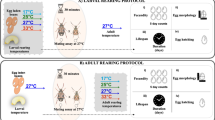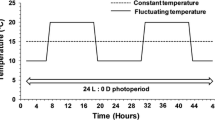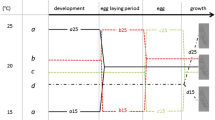Abstract
Females of Zeiraphera canadensis Mut. & Free., the spruce bud moth, were reared in the laboratory at constant and alternating temperatures, and in an outdoor insectary, to (1) determine the effects of temperature, age and size on several reproductive parameters and, (2) to test the hypothesis that body size-temperature interactions influence longevity and realized fecundity. Egg maturation was linearly related to age and large moths developed eggs at a higher rate than small ones. Mcan lifetime oviposition rate reached a maximum and remained stable at temperatures ≥20° C while the mean lifetime rate of egg maturation increased linearly with temperature, indicating that higher temperatures adversely affect oviposition. The production of nonviable eggs increased with age but also with temperature, suggesting high temperature (≥25° C) reduces egg quality and/or hinders fertilization. The realized fecundity and longevity of females reared under an alternating temperature regime (mean 20° C) was significantly less than that of females reared at constant 20° C. Similar realized fecundity, longevity and mean lifetime oviposition rates for females reared at temperatures alternating between 10 and 25° C (mean 20° C) and those at constant 25° C reflected the inability of females to recover from elevated diurnal temperatures. Longevity was positively related to female body size at constant 15 and 20° C but the relationships were negative for moths exposed to diurnal temperatures equal to or exceeding 25° C. Due to the reduced longevity of large moths at high temperatures, linear regressions between size and realized fecundity were only significant at constant temperatures ≤20° C. At higher temperatures, the size-fecundity relationship became curvilinear as a result of the diminished reproductive output of large individuals. Reduced fecundity and longevity of large females at high temperatures may have been due to elevated internal temperatures of large-bodied moths. Large females in a controlled-environment chamber maintained at 25° C developed an internal temperature excess (i.e. temperature above ambient) of nearly 2° C while small-bodied females exceeded ambient by only 0.3° C. However, when held at 20° C, the temperature excess of large-bodied moths was much less than 1° C and small-bodied females did not differ from ambient. Such interactions between temperature and body size suggest that there should be stabilizing selection toward moderate-sized individuals and may explain the absence of size-related effects on fecundity and longevity previously reported for several other lepidopterans.
Similar content being viewed by others
References
Adler PH, Willey MB, Bowen MR (1991) Temporal oviposition patterns of Heliothis zea and Spodoptera ornithogalli. Entomol Exp Appl. 58:159–164
Benz G (1969) Influence of mating, insemination, and other factors on oögenesis and oviposition in the moth Zeiraphera diniana. J Insect Physiol 15:55–71
Berger A (1989) Egg weight, batch size and fecundity of the spotted stalk borer, Chilo partellus in relation to weight of females and time of oviposition. Entomol Exp Appl 50:199–207
Blau WS (1981) Latitudinal variation in the life histories of insects occupying disturbed habitats: a case study. In: Denno RF, Dingle H (eds) Insect life history patterns: habitat and geographic variation. Springer-Verlag, New York, pp 75–95
Boggs CL (1986) Reproductive strategies of female butterflies: variation in and constraints on fecundity. Ecol Entomol 11:7–15
Digby PSB (1955) Factors affecting the temperature excess of insects in sunshine. J Exp Biol 32:279–298
Endler JA (1986) Natural selection in the wild. Princeton University Press, Princeton, New Jersey
Gerber GH (1975) Reproductive behaviour and physiology of Tenebrio molitor (Coleoptera: Tenebrionidae) II. Egg development and oviposition in young females and the effects of mating. Can Ent 107:551–559
Gerber GH, Howlader MA (1987) The effects of photoperiod and temperature on calling behaviour and egg development of the bertha armyworm, Mamestra configurata (Lepidoptera: Noctuidae). J Insect Physiol 33:429–436
Gilbert N (1984) Control of fecundity in Pieris rapae. I. The problem. J Anim Ecol 53:581–588
Greenfield MD, Karandinos MG (1976) Fecundity and longevity of Synanthedon pictipes under constant and fluctuating temperatures. Environ Entomol 5:883–887
Gu H, Danthanarayana W (1990) The role of availability of food and water to the adult Epiphyas postvittana, the light brown apple moth, in its reproductive performance. Entomol Exp Appl 54:101–108
Hagstrum DW, Leach CE (1973) Role of constant and fluctuating temperatures in determining development time and fecundity of three species of stored-products Coleoptera. Ann Entomol Soc Am 66:407–410
Heinrich B (1974) Thermoregulation in endothermic insects. Science 185:747–756
Hinton HE (1981) Biology of insect eggs, vols 1–3. Pergamon Press, Oxford
Jones RE, Hart JR, Bull GD (1982) Temperature, size and egg production in the cabbage butterfly, Pieris rapae L. Aust J Zool 30:223–232
Karlsson B, Wickman P-O (1990) Increase in reproductive effort as explained by body size and resource allocation in the speckled wood butterfly, Pararge aegeria (L.). Funct Ecol 4:609–617
Karlsson B, Wiklund C (1984) Egg weight variation and lack of correlation between egg weight and offspring fitness in the wall brown butterfly Lasiommata megera. Oikos 43:376–385
Lande R, Arnold SJ (1983) The measurement of selection on correlated characters. Evolution 37:1210–1226
Laugé G, Masner P (1974) Incidences de température élevées appliquées au cours du stade pupal sur les potentialités reproductrices des adultes de Drosophila melanogaster. Entomol Exp Appl 17:511–521
Leather SR (1984) The effect of adult feeding on the fecundity, weight loss and survival of the pine beauty moth, Panolis flammea (D & S). Oecologia 65:70–74
Leather SR (1988) Size, reproductive potential and fecundity in insects: things aren't as simple as they seem. Oikos 51:386–389
Leather SR, Burnand AC (1987) Factors affecting life-history parameters of the pine beauty moth, Panolis flammea (D & S): the hidden costs of reproduction. Funct Ecol 1:331–338
Marks RJ (1976) Mating behaviour and fecundity of the red boll-worm Diparopsis castanea Hmps. (Lepidoptera, Noctuidae). Bull Ent Res 66:145–158
Marshall LD (1990) Intraspecific variation in reproductive effort by female Parapediasia teterrella (Lepidoptera: Pyralidae) and its relation to body size. Can J Zool 68:44–48
May ML (1979) Insect thermoregulation. Ann Rev Entomol 24:313–349
Messenger PS (1964) The influence of rhythmically fluctuating temperatures on the development and reproduction of the spotted alfalfa aphid, Therioaphis maculata. J Econ Entomol 57:71–76
Miller TA, Cooper WJ, Highfill JW (1982) Relationships between pupal size and egg production in reared female Antheraea polyphemus. Ann Entomol Soc Am 75:107–108
Miller TA, Cooper WJ, Highfill JW (1983) Egg production in female Callosamia promethea (Lepidoptera: Saturniidae) as a function of pupal size and adult longevity. Ann Entomol Soc Am 76:668–670
Minkenberg OPJM, Helderman CA (1990) Effects of temperature on the life history of Liriomyza bryoniae (Diptera: Agromyzidae) on tomato. J Econ Entomol 83:117–125
Minkenberg OPJM, Ottenheim JJGW (1990) Effect of leaf nitrogen content of tomato plants on preference and performance of a leafmining fly. Oecologia 83:291–298
Pilon JG (1965) Bionomics of the spruce budmoth, Zeiraphera ratzeburgiana (Ratz.) Lepidoptera: (Olethreutidae). Phytoprotection 46:5–13
Proverbs MD, Newton JR (1962) Effect of heat on the fertility of the codling moth, Carpocapsa pomonella (L.) (Lepidoptera: Olethreutidae). Can Ent 94:225–233
Régnière J, Turgeon JJ (1989) Temperature-dependent development of Zeiraphera canadensis and simulation of its phenology. Entomol Exp Appl 50:185–193
Rodriquez-del-Bosque LA, Smith JW Jr, Browning HW (1989) Development and life-fertility tables for Diatraea lineolata (Lepidoptera: Pyralidae) at constant temperatures. Ann Entomol Soc Am 82:450–459
SAS Institute (1988) SAS/STAT User's Guide Release 6.03 Edition. SAS Institute, Cary, NC, USA
Shine R (1988) The evolution of large body size in females: a critique of Darwin's “fecundity advantage” model. Am Nat 131:124–131
Suzuki Y (1978) Adult longevity and reproductive potential of the small cabbage white, Pieris rapae crucivora Boisduval (Lepidoptera: Pieridae). Appl Entomol Zool 13:312–313
Thomas AW, Borland SA, Greenbank DO (1980) Field fecundity of the spruce budworm (Lepidoptera: Tortricidae) as determined from regression relationships between egg complement, fore wing length, and body weight. Can J Zool 58:1608–1611
Turgeon JJ (1985) Life cycle and behavior of the spruce budmoth, Zeiraphera canadensis (Lepidoptera: Olethreutidae), in New Brunswick. Can Ent 117:1239–1247
Turgeon JJ, Nelson N, Kettela EG (1987) Reproductive biology of the spruce bundmoth, Zeiraphera canadensis Mut. & Free. (Lepidoptera: Tortricidae: Olethreutinae), in New Brunswick. Can Ent 119:361–364
Wickman P-O, Karlsson B (1989) Abdomen size, body size and the reproductive effort of insects. Oikos 56:209–214
Wiklund C, Persson A (1983) Fecundity and the relation of egg weight variation to offspring fitness in the speckled wood butterfly Pararge aegeria, or why don't butterfly females lay more eggs? Oikos 40:53–63
Willmer PG, Unwin DM (1981) Field analyses of insect heat budgets: reflectance, size and heating rates. Oecologia 50:250–255
Author information
Authors and Affiliations
Rights and permissions
About this article
Cite this article
Carroll, A.L., Quiring, D.T. Interactions between size and temperature influence fecundity and longevity of a tortricid moth, Zeiraphera canadensis . Oecologia 93, 233–241 (1993). https://doi.org/10.1007/BF00317676
Received:
Accepted:
Issue Date:
DOI: https://doi.org/10.1007/BF00317676




